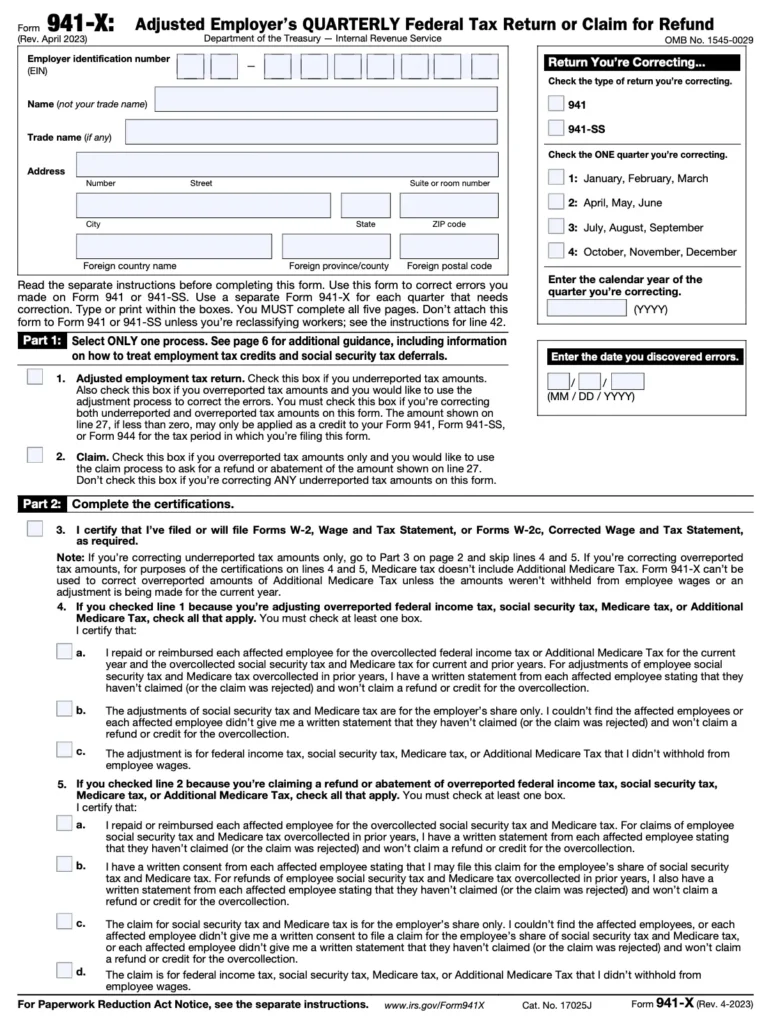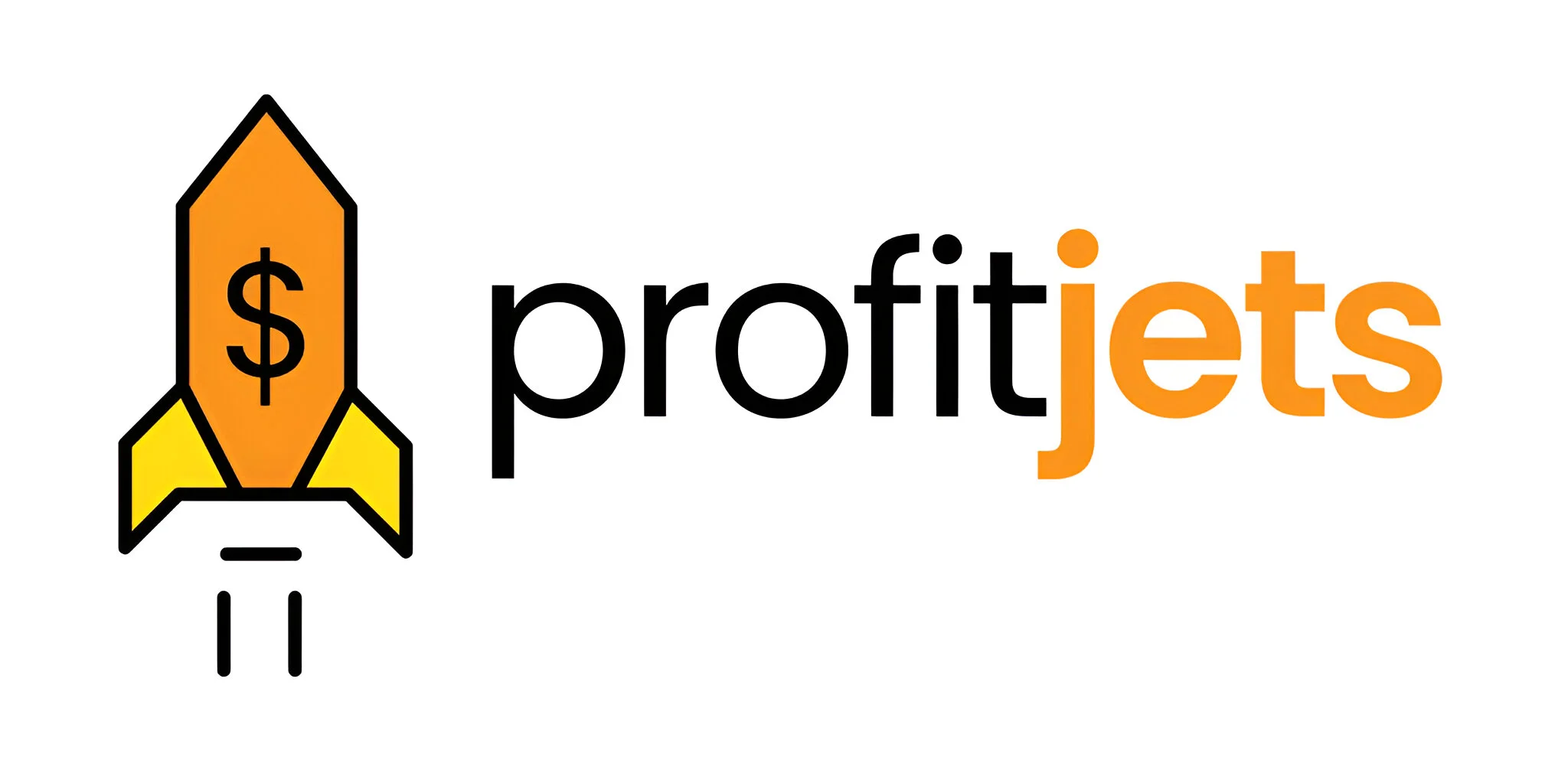Correcting errors on your quarterly payroll tax return is essential for maintaining accurate tax records and staying compliant with IRS requirements. Form 941‑X, the Adjusted Employer’s QUARTERLY Federal Tax Return or Claim for Refund, allows you to amend a previously filed Form 941 if you discover mistakes in your original submission. Whether it’s due to misreported wages, incorrect tax deposits, or miscalculated tax liabilities, filing Form 941‑X correctly can help you reclaim overpaid tax or rectify underreported amounts.
In this guide, we provide comprehensive Form 941‑X instructions and walk you through each step of completing the entire form. We also highlight how professional tax services can simplify this process.
What is Form 941‑X?
Form 941‑X is used by employers to amend their previously filed quarterly Form 941. If errors are found—whether in reported wages, withheld taxes, or tax deposits—this form allows you to correct them and claim a refund for any overpayment or adjust an underpayment on a prior quarter. Essentially, Form 941‑X is a tool to bring your payroll tax filings in line with IRS regulations and ensure that your business’s tax liability is accurate.
Who Must File Form 941‑X?
Any employer who has filed a Form 941 and later discovers an error in the amounts reported may need to file Form 941‑X. This applies to businesses of all sizes that withhold federal income tax, Social Security, and Medicare taxes from employee wages. If you find discrepancies—perhaps due to miscalculations or unintentional data entry mistakes—you must use Form 941‑X to amend your previous return. It’s crucial to review your payroll records periodically and consult the Form 941‑X instructions to determine if an amendment is necessary.

Why Filing Form 941‑X Accurately Matters
Submitting an accurate Form 941‑X is essential for several reasons:
- Regulatory Compliance: Correcting your filings ensures you adhere to IRS rules and avoid penalties.
- Accurate Tax Liability: Amending errors helps either reclaim overpaid taxes or adjust underpayments, keeping your business finances accurate.
- Record Consistency: A correct Form 941‑X provides a clear audit trail, which is valuable during IRS examinations.
- Enhanced Credibility: Accurately amending tax returns can help maintain your business’s reputation and credibility with the IRS.
By following our step-by-step instructions, you can correct errors efficiently and confidently, whether you handle payroll in‑house or rely on expert tax services.
Step-by-Step Instructions for Completing Form 941‑X
Below are detailed steps to complete Form 941‑X accurately. Each section is designed to help you navigate through the process, from identifying errors to filing the corrected return.
Step 1: Gather Your Records
Before you begin filling out Form 941‑X, collect all relevant documents and data from the quarter in question:
- Original Form 941: Keep a copy of the filed Form 941 for the quarter you wish to amend.
- Payroll Records: Gather payroll reports, deposit records, and any documents related to wages and taxes withheld.
- Bank Statements: Have your bank records handy to confirm tax deposit amounts and dates.
- Calculations: Recompute the tax liability to pinpoint the error(s) in the original return.
Organizing these documents will streamline the amendment process and minimize errors.
Step 2: Complete the Identification Section
Begin filling out Form 941‑X by providing basic identification information:
- Line 1: Enter the legal name of your business exactly as it appears on your original Form 941.
- Line 2: Input your Employer Identification Number (EIN).
- Line 3: Provide your business’s mailing address, ensuring consistency with your original filing.
- Line 4: Include any additional identifiers if required, such as a DBA name.
Double-check these details; any discrepancy may result in processing delays.
Step 3: Specify the Tax Period Being Amended
In this section, indicate the quarter for which you are filing Form 941‑X:
- Line 5: Enter the beginning and ending dates of the quarter you are correcting (for example, January 1 to March 31 for Q1). Use the proper date format as specified in the instructions.
- Line 6: Confirm whether the amended return is for a calendar quarter or a fiscal quarter.
Accurately identifying the tax period is critical for proper processing.

Step 4: Explain the Adjustments
This section is where you detail the changes required:
- Line 7: Clearly explain the nature of the adjustment. For example, note if you need to correct wages, tips, or tax deposits. Provide a concise explanation to help the IRS understand the correction.
- Line 8: Enter the exact figures for the amounts reported initially versus the corrected amounts. Include columns for both the original quantities and the corrections.
- Line 9: Calculate and report the net adjustment amount. This may be a positive number if you are claiming a refund or a negative number if additional tax is due.
Accurate calculations are essential here. Using payroll software or consulting professional tax services can ensure that your adjustments are correct.
Step 5: Recalculate Your Tax Liability
After entering your adjustments:
- Line 10: Recalculate the total tax liability for the quarter after adjustments.
- Line 11: Compare this recalculated tax liability with the total deposits made. This will determine if you have overpaid or underpaid your taxes.
Double-check these calculations to avoid further errors in your amendment.
Step 6: Provide Additional Details and Supporting Information
Some amendments require extra documentation:
- Line 12: Attach any supplemental schedules or financial statements that support your correction. These documents may include detailed payroll reports, bank deposit confirmations, or corrected worksheets.
- Line 13: If applicable, explain any adjustments made due to changes in taxable wages, tips, or corrections to previously reported amounts.
Supporting documentation ensures that the IRS can verify your corrections efficiently.
Step 7: Review, Sign, and Date the Form
Before submitting:
- Review All Entries: Thoroughly review every section of the form for accuracy. Compare your entries against your original documents and payroll records.
- Sign and Date: Sign and date the form in the designated section. If filing electronically, follow the IRS guidelines for electronic signatures.
A careful review is crucial to prevent additional amendments later.
Step 8: Submit Your Amended Return
Finally, file your amended return:
- Electronic Filing: Many businesses now choose to file Form 941‑X electronically via the IRS e-file system. E-filing generally results in faster processing and confirmation.
- Mailing: If you decide to file a paper return, send Form 941‑X along with any required attachments to the IRS address provided in the current instructions. Consider using certified mail for proof of delivery.
- Keep Copies: Always retain a copy of the completed Form 941‑X and all supporting documentation for your records. This documentation is important in case of future IRS inquiries or audits.
Following proper submission procedures ensures that your correction is processed promptly and correctly.
Additional Best Practices
- Maintain Organized Payroll Records: Keeping thorough records throughout the year will simplify any amendments you may need to make later.
- Review Regularly: Periodically review your payroll and tax deposit records to catch any discrepancies early.
- Consult Professional Tax Services: If you encounter complexities or are unsure about any part of the process, consider seeking guidance from professional tax services. Their expertise can save you time and help avoid costly mistakes.
- Use Reputable Software: Utilize reliable payroll or accounting software that can automatically track and report data accurately.
Leveraging Professional Tax Services
Filing an amended payroll tax return via Form 941‑X can be intricate, especially if your business has multiple payroll cycles or complex deposit patterns. Professional tax services can provide invaluable support by:
- Ensuring Accuracy: Experts review your calculations and reconcile discrepancies to prevent errors.
- Streamlining the Process: Experienced advisors can help gather necessary documents and complete the form efficiently.
- Offering Peace of Mind: With professional guidance, you can confidently meet IRS requirements and avoid potential penalties.
- Customized Solutions: Tax services can tailor their approach based on your business’s size and complexity, ensuring a personalized and effective solution.
Investing in expert tax services not only makes the filing process smoother but also safeguards your business against potential compliance issues.

Final Thoughts
Filing Form 941‑X is a critical process for correcting errors in your quarterly payroll tax returns. By following this step-by-step guide and carefully reviewing each section, you can accurately complete the form and ensure that your tax liability is adjusted correctly. From gathering all necessary records and verifying your calculations to submitting your amended return on time, every step is essential in maintaining compliance with IRS regulations.
Whether you choose to handle the process internally or engage professional tax services, taking the time to file Form 941‑X correctly will help you avoid potential penalties and create a clear, accurate record of your tax obligations. A well-prepared amendment not only corrects past errors but also strengthens your business’s overall financial management.










